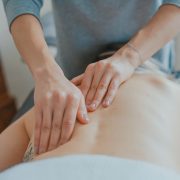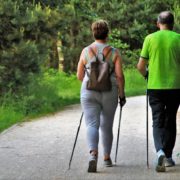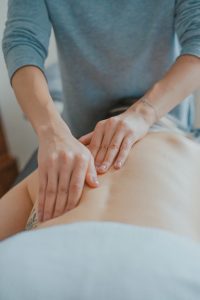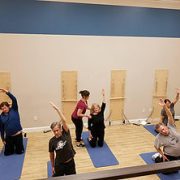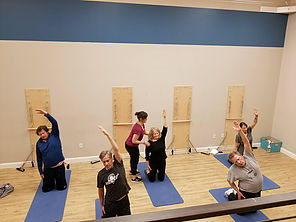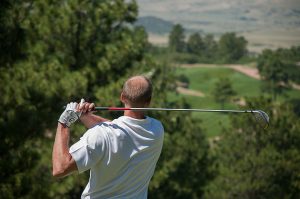7 Reasons Everyone over 50 Should be Walking
A meet a lot of folks who think (or have been told) they need to “slow down” once they get into their 50’s and beyond – especially if they have arthritis or an injury. But this can’t be farther from the truth. As we age, regular movement and exercise becomes even more critical – especially if you’re injured or suffering from arthritis.
If it’s been awhile since you’ve exercised, or you’re looking for something you can do that’s accessible and where you can be consistent, then let’s talk about all the benefits a walking routine can bring you – especially if you’re in your 50’s and beyond.
Here are 7 reasons why I think everyone over 50 should be walking:
-
It’s good for your cardiovascular health
The leading cause of death in older adults continues to be cardiovascular disease. A regular walking routine can help combat this by improving your heart health, increasing your blood circulation, it reduces bad cholesterol, and raises the good cholesterol. Plus – the rhythmic nature of walking gets your heart pumping at a steady rate – which is great for your overall cardiovascular health.
-
It makes your muscles and bones stronger
As we age, losing both bone density and muscle mass are normal and common. But there are things you can do to counteract this process – and regular walking is one of them. Since walking is a weight-bearing activity, it’s good for strengthening your bones and reducing the risk of osteoporosis and fractures. Walking also engages several of your muscle groups at once – which helps them to stay active and strong.
-
It’s boosts your mental health
Ever heard of walking meditation? It’s a thing. Walking has been shown to significantly reduce symptoms of depression and anxiety, and it’s an opportunity to get your mind off the day to day, self reflect, and even meditate as I mentioned above. Plus – if you assume a regular walking routine with friends or loved ones, the social aspect can be so beneficial to your mood and mental health. To further enhance the mental benefits of walking – try to get out in nature. The fresh air – plus tranquil sounds and smells – is not only cleansing for your mind – but for your soul as well.
-
It helps you manage weight
Along with bone density and muscle mass, your metabolism also takes a hit as you get older. But regular walking can help counteract this. Regular walking burns calories to help you maintain a healthy weight, which is critical for avoiding chronic diseases such as diabetes and heart disease. Plus, being at a healthy weight can increase your energy levels, it’s easier to move around and do your daily tasks, and you’ll have less stress on your joints.
-
It improves your joint health
A lot of people don’t realize this – but arthritis is something that occurs naturally as you age and it’s not something to be feared. But because we fear it, we unknowingly avoid activities that are good for us and that actually help arthritis. Walking is one of these activities. Movement is one of the best things you can do for arthritis, and walking in particular helps to lubricate your joints, especially your knees and hips. Regular walking also helps to make the structures and soft tissue around your joints loose and flexible – which is important for successful management of arthritic joints.
-
It helps enhance your balance and coordination
As we get older, falls become a major concern because lower bone density means you’re more prone to fractures. It gets more difficult to work on balance and coordination after you’ve lost it – so maintaining it is key. A regular walking routine does just that. Each step you take requires coordination of several muscles as well as balance – and the repetitiveness of wal
king helps enhance your body’s natural ability to quickly correct and stabilize itself – all helping you to decrease your risk of falling.
-
It’s low impact and adaptable
One of the reasons I recommend walking for folks over 50 is because of its low-impact nature. Unlike jogging or other high-impact exercises, walking is gentle on the joints and can be easily adapted to your current fitness level. Whether it’s a slow-paced walk around the block or a brisk hike up a hill, walking can be tailored to suit your individual needs and goals

If you’re over 50 – incorporating regular walking into your routine can be a game-changer. It’s a simple yet profoundly effective way to get and stay fit – and you’ll find it improves your quality of life in ways that are beyond physical. Walking nurtures your mind and soul, is a great way to catch up with friends and stay social, and you can literally do it anywhere. If you’re not already incorporating a regular walking routine – what are you waiting for? And if an injury is what’s stopping you – talk to an expert who can help you get rid of your pain and get started in a way that is safe for your body.
Learn more about our next exclusive free live event – Fit After 50 – HERE.
Dr. Carrie Jose, Physical Therapist and Pilates expert, owns CJ Physical Therapy & Pilates in Portsmouth and writes for Seacoast Media Group. To get in touch, email her at [email protected].


